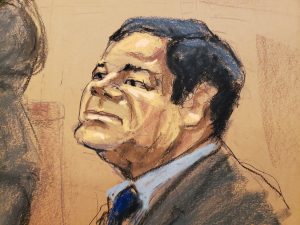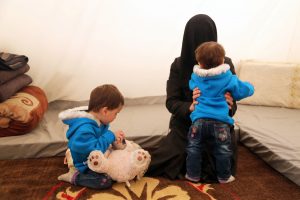
By Brendan Pierson
NEW YORK (Reuters) – Joaquin “El Chapo” Guzman was someone who decided “who lives and who dies,” a prosecutor said in closing arguments in the accused Mexican drug kingpin’s trial in the United States.
“The government does not have to prove that he was the boss, or the only boss, or even one of the top bosses,” Assistant U.S. Attorney Andrea Goldbarg told jurors, though she hastened to add that Guzman was “one of the top bosses, without a doubt.”
Guzman’s lawyers have claimed the cartel’s real leader is Ismael “El Mayo” Zambada, who remains at large, and that their client was framed by Zambada.
Standing in front of a table piled with trial evidence including assault rifles and bricks of cocaine, Goldbarg took a calm, no-nonsense approach as she walked the jury in federal court in Brooklyn through the charges against Guzman one by one.
Guzman, 61, was extradited to the United States in January 2017. The 10 criminal counts include engaging in a continuing criminal enterprise, drug trafficking and money laundering conspiracy, and a life sentence if he is found guilty.
Goldbarg’s summation capped an exhaustive government case that spanned 10 weeks of testimony from more than 50 witnesses, including law enforcement officials and former associates of Guzman who are cooperating with the U.S. government after striking plea deals.
Guzman’s lawyers have aggressively sought to undermine the cooperators’ credibility in their cross-examinations, something Goldbarg addressed head on.
“These witnesses were criminals,” she said. “The government is not asking you to like them.”

Accused Mexican drug lord Joaquin “El Chapo” Guzman sits in court in this courtroom sketch during Guzman’s trial in Brooklyn federal court in New York City, U.S., January 30, 2019. REUTERS/Jane Rosenberg
However, she said, their testimony was corroborated by intercepted phone calls, text messages and letters from Guzman, as well as accounting ledgers seized in a raid on one of his safe houses.
“You know these cooperating witnesses are telling the truth because you heard the same thing from the defendant’s own mouth,” she said.
The intercepted communications showed Guzman plotting drug shipments, dealing with corrupt government officials and, sometimes, ordering his adversaries killed.
“He’s the one who decides who lives and who dies,” Goldbarg said.
Goldbarg then moved methodically through the evidence linking Guzman to each of a series of drug seizures by authorities in the 1990s and 2000s. Her argument is expected to last the rest of the day.
Guzman called only one witness in his defense on Tuesday. One of his lawyers is expected to deliver his closing argument on Thursday.
(Reporting By Brendan Pierson in New York; Editing by Anthony Lin and Grant McCool)




